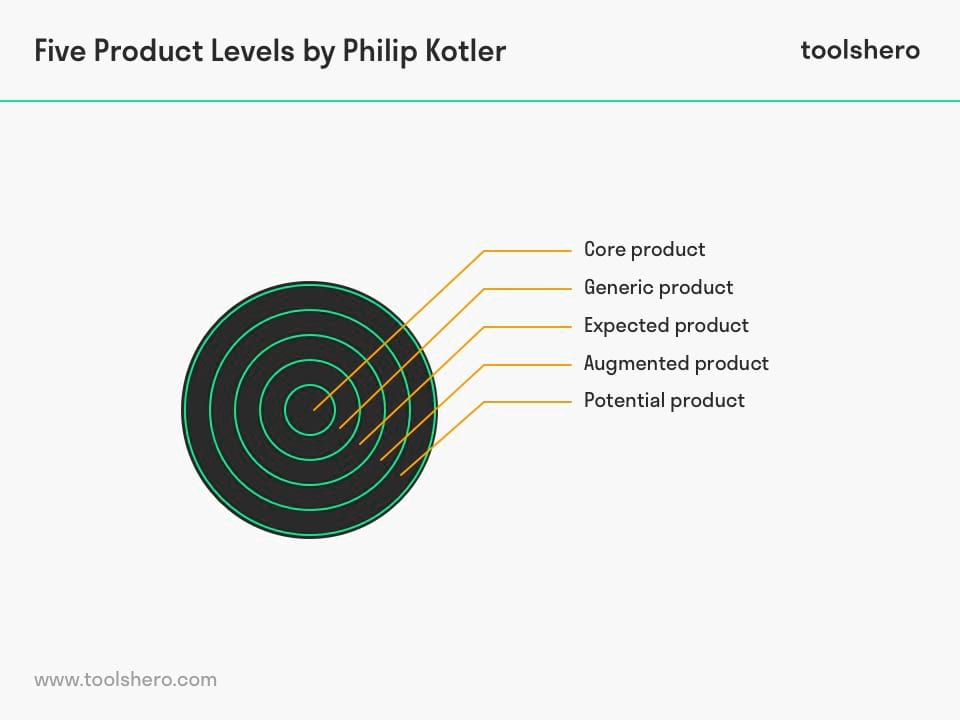Five Product Levels by Philip Kotler

Five Product Levels: this article describes the Philip Kotler Five Product Levels, developed by Philip Kotler in a practical way. Next to what it is, this article also hightlights the five levels, the competition, the added value and a Five Product Levels template to get started. Enjoy reading!
What is a product?
According to Philip Kotler, who is an economist and a marketing guru, a product is more than a tangible ‘thing’. A product meets the needs of a consumer and in addition to a tangible value this product also has an abstract value.
For this reason Philip Kotler states that there are five basic levels that can be identified and developed.
In order to shape this abstract value, Philip Kotler uses five product levels in which a product is located or seen from the perception of the consumer.
These 5 Product Levels indicate the value that consumers attach to a product. The customer will only be satisfied when the specified value is identical or higher than the expected value.
What are the Kotler Five Product Levels?

Figure 1 – Five Product Levels (Kotler)
1. Core Product
This is the basic product and the focus is on the purpose for which the product is intended. For example, a warm coat will protect you from the cold and the rain.
The more important core benefits the product provides, the more that customer is satisfied and need the product. A key element is the uniqueness of the core product. This will benefit the product positioning within a market and effect the possible competition.
2. Generic Product
This represents all the qualities of the product. For a warm coat this is about fit, material, rain repellent ability, high-quality fasteners, etc.
3. Expected Product
This is about all aspects the consumer expects to get when they purchase a product. That coat should be really warm and protect from the weather and the wind and be comfortable when riding a bicycle.
4. Augmented Product
The Augmented Level for a product refers to all additional factors which sets the product apart from that of the competition.
And this particularly involves brand identity and image.
Is that warm coat in style, its colour trendy and made by a well-known fashion brand? But also factors like service, warranty and good value for money play a major role in this.
The goal is to deliver something that is beyond an expected product. It’s the translation of the desire that is converted into reality.
5. Potential Product
This is about augmentations and transformations that the product may undergo in the future. For example, a warm coat that is made of a fabric that is as thin as paper and therefore light as a feather that allows rain to automatically slide down.
Competition
The competition between businesses focuses mainly on the distinctiveness of the Augmented Product according to Philip Kotler.
It is about the perception a consumer experiences when purchasing a product and it is not so much about value.
Kotler states: “Competition is determined not so much by what companies produce, but by what they add to their product in the form of packaging, services, advertising, advice, delivery (financing) arrangements and other things that can be of value to consumers”.
Five Product Levels as marketing strategy
For production companies it is important to deliver products in an upward trend from ‘Core Product’ to ‘Augmented Product’ and to have the potential to grow into the ‘Potential Product’.
Under the guise of stagnation means decline, innovative companies such as Philips and Volkswagen focus on the latter category.
Added value of the Five Product Levels
Each level of the five product levels adds value for the customer. The more efforts production companies make at all levels, the more likely they are to stand a chance to be distinctive.
At the Augmented Product level, the competition is observed in order to copy certain techniques, tricks and appearance of each other’s products.
This makes it increasingly difficult for a consumer to define the distinctiveness of a product or service.
To be able to tower over the competition, production companies focus on factors which consumers attach extra value to such as extreme packaging, surprising advertisements, customer-oriented service and affordable payment terms.
This is not just about satisfying the customers and exceeding their expectations but also about surprising them.
Five Product Levels template
Start describing the different product levels with this ready to use Five Product Levels template.
Download the Five Product Levels template
This template is exclusively for our paying Toolshero members. Click here to see if a membership is something for you!It’s Your Turn
What do you think? What are the Five Product Levels of today’s marketing? What is the influence of social media on these product levels? For example, LinkedIn targeting enables brands to reach all prospect customers with awareness campaigns, and use specific narratives that are in alignment with the five product levels. Furthermore, LinkedIn is still the best platform to reach out to the various stakeholders that would be likely to invest in your business.
Share your experience and knowledge in the comments box below.
More information
- Kotler, P. & Sidney J. Levy. (1969). Broadening the Concept of Marketing. Journal of Marketing, January 1969, Vol. 33, Issue 1, pp.10-15. (Winner of the 1969 Alpha Kappa Psi Foundation Award for the best 1969 paper in the Journal of Marketing.)
- Kotler, P. (1967). Marketing Management: Analysis, Planning and Control. Prentice Hall.
How to cite this article:
Mulder, P. (2012). Five Product Levels (Kotler). Retrieved [insert date] from Toolshero: https://www.toolshero.com/marketing/five-product-levels-kotler/
Original publication date: 03/14/2012 | Last update: 01/17/2024
Add a link to this page on your website:
<a href=”https://www.toolshero.com/marketing/five-product-levels-kotler/”>Toolshero: Five Product Levels (Kotler)</a>













3 responses to “Five Product Levels by Philip Kotler”
I need to explain the five levels of product using a treadmill, same as above example.
Hi Kavinda, all that power lies in your own hands 🙂 The written example is for explanation and inspiration.
Pick two product categories – one should be a physical good and the other should be a service. For each product that you have selected, outline how the five product levels could be structured (similar to the examples listed above). i cannot understand this Q. Can any one explain it with example?